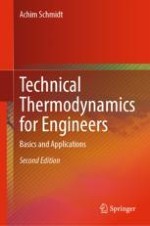2022 | OriginalPaper | Buchkapitel
12. Caloric Equations of State
verfasst von : Achim Schmidt
Erschienen in: Technical Thermodynamics for Engineers
Aktivieren Sie unsere intelligente Suche, um passende Fachinhalte oder Patente zu finden.
Wählen Sie Textabschnitte aus um mit Künstlicher Intelligenz passenden Patente zu finden. powered by
Markieren Sie Textabschnitte, um KI-gestützt weitere passende Inhalte zu finden. powered by
